Being successful in establishing sustainable Integrated Conservation and Development Programs (ICDPs) requires a clear training and education program which place the education clearly within a framework of practical applications.
The ICDPs can result in economic benefits to the community, but that is often insufficient to guarantee sustainability because of fairly inevitable disruptions to lifestyle, traditional ways of earning a living (farming as opposed to formal employment). Further, satisfaction may plummet because perceived social inequality and restrictions on former lifestyles (SilvaJulie, 2014).
Situated learning is critical in the development and implementation of ICDPs:
• Conservation involves preservation of ecosystems
o Identify elements of ecosystems
o Explain which elements are most vulnerable
• Dealing with unexpected consequences: reduced opportunities for agricultural production, restriction of activities at home
o Describe the changes to communities and shared resources that require restricted activities (no agricultural expansion, changed practices)
o Identify the new types of activities and the skills requirements
o Create a plan for developing local talent for jobs with responsibility
o Identifying potential areas of social disruption / loss of cultural authenticity
• Taking advantage of economic development resources
o Create collaborations between locals and renowned experts for developing project plans
o Construct systems for administering new programs
o Develop lists of available incentives (tax credits, infrastructure projects, corporate promotions)
o Identify human resources and the needs to be satisfied
Implementing the situated learning approach requires the following elements:
• Collaborations, both face-to-face and with virtual communities of interest (Akoumianakis, 2014)
• Wiki or portfolio development of goal-focused information, such as habitat analysis, botanical information, etc.
• Repositories of information for marketing/outreach as well as operations (Libord & Hjalager, 2010)
• Enacted social formations (Akoumianakis, 2014); travel communities (Lonely Planet, etc.) and virtual business communities (Travelocity, etc.)
• Knowledge management for communities of interest
Case Study: Sayulita, Nayarit, Mexico
Sayulita, Mexico, which is an economy driven primarily by tourism, is a perfect location for the implementation of an ICDP, which in turn could benefit from the application of situated learning.
Sayulita is a fishing and surfing town on the west coast of Mexico north of Puerto Vallarta in the state of Nayarit. It has been featured in a number of books about world-class surf sites, and has also become a destination point for Canadian and American tourists and retirees. It has a bohemian vibe, and as opposed to Puerto Vallarta or Nuevo Vallarta, Sayulita does not allow large developments.
The goal of many property owners in Sayulita is to expand / develop the area, especially as funds pour into the “Nayarit Riviera” in Puerto Vallarta, Nuevo Vallarta, and Punta Mita. The challenge for the property owners in Sayulita is that many of them are small holders, and also may not be full-time residents. Some are retirees and want to try a second career, but have no idea how to get started.
Further, they are very interested in protecting their investments, and a few recent developments have caused many owners to worry. For example, there is insufficient parking in the town, which is exacerbated by the fact that many restaurants place few tables inside. Instead, they put tables on the sidewalks, and even into the street itself, where diners run the risk of being run over by an errant car. They also have to contend with eating a lot of dust, and being menaced by the hordes of mongrel dogs and escaped chickens that roam the streets, adding to both charm and public health concerns.
Another concern is the fact that the few roads that provide access to the beach are very narrow, and often clogged by SUVs parking on the side. Further, the beach on the side of the cemetery, the “Playa de los Muertos” has less parking than ever since three food stands have opened, literally between and in front of the tombs. A charming location runs the risk of becoming a rather crass and potentially unwholesome crush. The recent developments run the risk of degrading the environment as well as the cultural heritage and authenticity. It also runs the risk of exacerbating social inequality, and stripping the Sayulita original inhabitants of their culture and traditional ways of earning a living (Falk, etal, 2012).
The challenge for the property owners involves the following:
• Developing a strategy for preserving the environment
• Creating an economic development program
• Design a plan that integrates property interests and economic development via nature tourism
In order to be effective, all the activities will require learning programs, all of which should be closely aligned with the strategic goals and mission of the stakeholders.
References
Akoumianakis, D. (2014) Ambient affiliates in virtual cross-organizational tourism alliances: A case study of collaborative new product development.Computers in Human Behavior, Volume 30, January 2014, Pages 773-786
Falk, J. H, Ballantyne, R, Packer, Pierre Benckendorff, P. (2012) Travel and Learning: A Neglected Tourism Research Area. Annals of Tourism Research, Volume 39, Issue 2, April 2012, Pages 908-927
Libord, J., Hjalager, A. (2010) Changing Approaches Towards Open Education, Innovation and Research in Tourism, Journal of Hospitality and Tourism Management, Volume 17, Issue 1, 2010, Pages 12-20
SilvaJulie A., Lila K. Khatiwada (2014) Transforming Conservation into Cash? Nature Tourism in Southern Africa. Africa Today, Vol. 61, No. 1, Special Issue: Narratives of the African Landscape: Perspectives on Sustainability (Fall 2014), pp. 17-45


